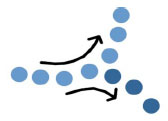

A book by Herb Stevenson, Volume 1. Learn more on Amazon.
Thoughts II:
The Next Step: A Calling

Volume 2 of 3. Learn more on Amazon.
Thoughts III:
Creating The Container

Volume 3 of 3. Learn more on Amazon.
To Lead
Read the article about training with Herb Stevenson in ALN Magazine.
See the article...
Caveat Executive—Coaching the Principle of Continuity: The Momentum Trap & Active Inertia
Herb Stevenson, CEO
July 7, 2013
 In the June 2013 issue, we noted that certain perceptual patterns can become problematic for executives and their organizations. One of the gestalt perceptual patterns discussed was the Principle of Continuity. It suggests that like Newton’s Law, where physical momentum persists in its state of motion unless acted upon by an external force, we tend to develop lines of thought by adopting preconceived meaning-making, such as agreed upon goals or ways to solve problems that do not change unless consciously interrupted. This commonly occurs when clients can become highly rigid in “how things are to be done” and do not consider the most appropriate procedure to address the issue at hand.
In the June 2013 issue, we noted that certain perceptual patterns can become problematic for executives and their organizations. One of the gestalt perceptual patterns discussed was the Principle of Continuity. It suggests that like Newton’s Law, where physical momentum persists in its state of motion unless acted upon by an external force, we tend to develop lines of thought by adopting preconceived meaning-making, such as agreed upon goals or ways to solve problems that do not change unless consciously interrupted. This commonly occurs when clients can become highly rigid in “how things are to be done” and do not consider the most appropriate procedure to address the issue at hand.
Michelle Barton andd Kathleen Sutcliffe refer to this phenomenon as “dysfunctional momentum” (Learning When to Stop Momentum, MITSloan Management Review, Spring, 2010, Vol. 51, No. 3. 69-76). Dysfunctional momentum “occurs when people continue to work toward an original goal without pausing to recalibrate or reexamine their processes, even in the face of cues that suggest they should change course.” (69) When an executive or executive team is in the middle of a dynamic and complex situation, they often get so engrossed in what they are doing they don’t notice that things have changed since the original conceptualization process. Another possibility is that they ignore signals suggesting that the problem has shape-shifted into something else, based on a completely different set of core assumptions that indicate that they should alter their course. The next thing they know, they are faced with an unforeseen crisis. Barton and Sutcliffe call such momentum dysfunctional when people or teams continue to engage in, or inadequately interrupt, a course of failing action. (70)
Donald Sull sheds further light on the complexity of the issue in his concept of active inertia (Why Good Companies Go Bad, HBR, July-August, 1999). In his description, “inertia is usually associated with inaction-–picture a billiard ball at rest on a table-–but physicists also use the term to describe a moving object’s tendency to persist in its current trajectory. Active inertia is an organization’s tendency to follow established patterns of behavior–-even in response to dramatic environmental shifts. Stuck in the modes of thinking and working that brought success in the past, market leaders simply accelerate all their tried-and-true activities. In trying to dig themselves out of a hole, they just deepen.”
Coaching the Situation
As executive coaches, active inertia and dysfunctional momentum are at the core of the gestalt perceptual principle of continuity. On one hand, a course of action based on prior successes creates a mobilization of focused energy (momentum). On the other hand, active inertia creates a false sense of security that a situation is sufficiently similar to prior situations and that the problem will in all likelihood be solved, without much further attention to the conceptualization of the problem. In short, the executive has mobilized the organization towards a preconceived solution without sufficiently determining what is different or unique. Moreover, because the solution has a history of prior success, the lens used by the executive to monitor progress is unlikely to allow for new data that would indicate that the problem is inaccurately defined. Therefore, the solution will NOT work. His/her thinking becomes self-sealed and unavailable for self-examination.
For example, when the S & L debacle occurred years ago, it was common for institutions to become lost in dysfunctional momentum. The self-sealed story of active inertia they told themselves was that “we’ve been through this before and we need only to weather the losses”, when in actuality the industry had dramatically changed. Donald Regan, under Ronald Reagan’s direction, had deregulated interest rates for all commercial banks and Savings & Loan Associations. Business was no longer a matter of collecting deposits and making sound loans with a fixed margin for profits; it was now managing interest rate risk as well. For twenty- to forty-year veterans of the industry, these changes created a massive gap between their perceptions of how to soundly manage the institutions and what was now required to be successful.
Caveat Executive
The principle of perceptual continuity suggests that executives and their coaches need to maintain a deep appreciation for the potential for a “caveat executive” to evolve. Caveat executive can be loosely defined as executive beware of thyself. It is easy to ignore the core assumptions driving every decision and initiative. Instead of assuming similarities to prior problems, the coach can support the executive to constantly assess what is different, whether it is in conceptualization of the problem and monitoring the environment or in mobilizing energy around misapplied solutions.
According to Barton and Sutcliffe, “dysfunctional momentum is not necessarily a problem of failing to sense important signals but of interpreting and incorporating the cues that are sensed. When we are involved in a course of action, we tell ourselves a story about what is happening at present and what is likely to happen afterward. The more we become preoccupied with past successes and their application to ongoing plans and activities, the more the forces of momentum tend to prevent us from reevaluating that story.” (72)
The Dynamic of Failure
Donald Sull provides even greater insight into areas that can be examined to understand the dysfunctional momentum and moreover, the self-sealing, active inertia that is supporting the momentum. He cites four areas that can be brought to the attention of the executive to support a refreshed perception of the situation
| Executive Focus | What To Question | Active Inertia |
| Strategic Frames | The set of assumptions that determine how managers view the business | Blinders |
| Processes | The way things are done | Routines |
| Relationships | The ties to employees, customers, suppliers, distributors, and shareholders | Shackles |
| Values | The set of shared beliefs that determine corporate culture | Dogmas |
Change Requires an Interruption
One of the tenets of gestalt theory is that in order for a change to occur, the person or system must be interrupted. The interruption is intended to shift the client to one degree or another so as to reexamine the present assumed perceptions and to reveal the self-sealed assumptions. Furthermore, it is the obligation of the gestaltist to bring to the client or system what it does not have or cannot see. When lost in dysfunctional momentum and active inertia, the people in charge need to stop and reassess what is happening around them. Hence, it is the executive coach that needs to interrupt the dysfunctional momentum or break the self-sealed, active inertia by bringing in new perspectives.
For example, when working with a non-profit social services agency, it was noted that the client organization predominately served the African-American community. Within the doors of the building was a rich cultural heritage. However to the public, it was seen as just another vanilla social service agency. In fact, the marketing materials did not suggest it was a culturally enriched agency. When this was indicated to the leadership of the organization, there was dead silence. Once the silence was broken, a lively conversation took place regarding what could happen if a more culturally portrayed approach was taken. Twenty years later, this agency is vibrant and actively and publicly embraces its cultural riches.
To overcome dysfunctional momentum, the executive coach needs to determine how to interrupt the client’s perceptions of the situation until the executive is able create the interruption him or herself. Dysfunctional momentum derives from the perception that a situation is unfolding as expected. Active inertia prevents the executive from even considering the need to reexamine the situation. Interruptions of the thought processes based on assumptions that may no longer be valid provide an opportunity to question the unexamined, self-sealed story. The most successful executives are able to create and/or welcome these kinds of interruptions. Unsuccessful executives tend to have a lack of interruptions by preventing or ignoring them. As a result, the lack of interruptions poses a threat to the executive’s abilities to make sense of a growing problem, update his/her understanding of the circumstances and, if appropriate, to change the course of action.
For example, the goal of the executive coach iss to bring insight into not only more effective leadership through behavioral changes but also to improve the executive’s ability to perceive differently. The latter is one of the causes of executive derailment after a promotion. He/she relies on tried and true perceptions (active inertia) of how to perform well when the blueprint applies to the prior job and not to the present position (dysfunctional momentum). It is only when the executive lets go of the more “hands-on” approach of the past and begins to support the work of others in the present, that the client begins to see differently and therefore is able to move into the new position.
The Principle of Perceptual Continuity
A critical aspect of perceptual principles is that they are self-sealed; that is, the executive tends to be lacking in the capacity to witness him or herself unless self-examination has been cultivated. The coach brings a new set of eyes to support self-examination and therefore for the executive to begin to see what was hidden from him or herself.
For example, a highly successful new product development executive struggled with impulse control. Recognized as brilliant and disruptive, he was tolerated. In some meetings, he could hijack the conversation by suddenly redirecting the focus to something that “popped” into his head. Generally, this was something that had nothing to do with the topic at hand. During a global planning meeting, he managed to control his impulsiveness for the first day. However, in day two, he was interrupting the meeting so frequently that it felt like a pinball game with five balls in play. Rather than to embarrass him, I redirected the executive to self examine his process and to reflect on how his behavior impacted the meetings. He was able to see that when he became anxious, he would lose self control. Furthermore, he recognized that he was totally disruptive to the flow and work of the team. After some further reflection he noted that he needed to address how to better manage his anxiety and to better manage it during meetings. When asked to consider how his behavior had served him in the past, he realized that he was reenacting a period where he was not able to bring his voice to important meetings. His style had evolved from a different organization with different executives. With this information, he recognized that he could make his voice heard without being so disruptive.
Conclusion
As discussed in this article, dysfunctional momentum and active inertia can contribute to the gestalt principle of continuity. By unraveling the principle, practical applications were provided for your use in executive coaching. In my experience, I have found that providing the client with information regarding dysfunctional momentum and active inertia through conversation or written materials has increased awareness and curiosity. It has led to their increased ability to self-reflect and engage in more effective leadership behavior.
We Appreciate Your Feedback
Please let us know if you found this article interesting or useful. We will not submit this information to any third parties.

